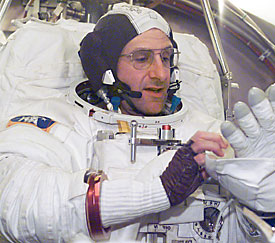 |
|
Photo courtesy of NASA
|
Donald Pettit is the third UA alumnus to enter space. He graduated in 1983 in chemical engineering and was selected by NASA in 1996.
|
|
By James Kelley
Arizona Daily Wildcat
Friday November 8, 2002
Donald Pettit will aid in construction, scientific research
While some alumni take campus tours, attend the parade or the football game this weekend, Donald Pettit will be going into outer space.
He will be the third UA alumnus to do so.
Pettit is scheduled to launch between 10 p.m. Sunday and 2 a.m. Monday, on the 16th shuttle flight to visit the international space station. The countdown for the launch begins today.
Pettit, who received his doctorate in chemical engineering from the UA in 1983, will be launching from the National Aeronautics and Space Administration's Lyndon B. Johnson Space Center in Houston for a four-month stay on the international space station, where he will perform scientific experiments and help construct more of the space station.
Dean of the College of Engineering and Mines, Tom Peterson, who was Pettit's adviser and still keeps in contact with him via e-mail, has noticed that the already enthusiastic Pettit has gotten more excited as the lift-off date nears.
"Absolutely. He definitely has gotten more excited and so have I," said Peterson, who is also a chemical and environmental engineering professor and former head of the chemical and environmental engineering department
Peterson is among the UA contingent that will be on hand for the launch. Pettit was the first student Peterson ever advised.
"A number of people with Arizona ties are coming: his classmates, I will, some professors from here and Oregon State," Peterson said. "It will be a nice event. I hope the weather will be fine."
Pettit was selected by NASA in 1996 and received his bachelor's degree from Oregon State University.
Pettit is the science officer for Expedition 5 to the international space station, a joint effort of the United States, Russia and Japan, among other countries.
"My role will be two hats ÷ as a flight engineer and the science officer," Pettit, told the Wildcat in September, before going into quarantine for the past two weeks. "From the engineer point of view, I will be helping build the station. There is still lots of construction to do and I will be in charge of doing payload experiments."
Prior to working at NASA, Pettit worked at Los Alamos National Laboratory in New Mexico for 12 years, where some of his most notable projects were experiments on reduced gravity flow onboard NASA's KC-135 airplane, which replicates the weightless, or "zero-gravity," environment of space flight. Pettit also helped assemble the technology to explore Mars in 1990.
From a young age, Pettit has wanted to go into space.
"Ever since I was a little kid, I remember John Glenn going up," Pettit told the Wildcat in September.
Though it was a lifelong dream of his, Pettit said in his NASA interview for the mission packet that he didn't think of applying for the program until he was graduating from the UA.
"It wasn't until I was graduating from graduate school that I thought of putting an application in to the program and applying to be an astronaut," Pettit said.
"And from graduate school at University of Arizona I went to Los Alamos National Laboratory, where I functioned as a staff scientist there. And eventually, I got an invitation to come in for an interview for astronaut," he said.
The other two alumni to have been in outer space are Tom Jones, who received a Ph.D. in planetary science in 1988 and logged over 52 days, 1,272 hours in space, including 3 space walks that totaled over 19 hours; and Francis "Dick" Scobee, a graduate in aerospace engineering in 1965, who died in the Challenger shuttle explosion in 1986.
Pettit said he is anxious to get back to campus when he has a chance, and has been active at the UA since graduation.
He is a member of the Chemical and Environmental Engineering's Industrial Advisory Committee, which meets every year, but has missed the last two meetings because of space station training in Russia.

